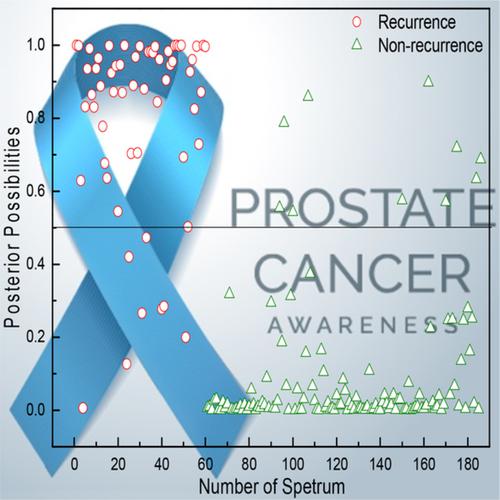当前位置:
X-MOL 学术
›
J. Biophotonics
›
论文详情
Our official English website, www.x-mol.net, welcomes your
feedback! (Note: you will need to create a separate account there.)
Therapeutic prognosis of prostate cancer using surface-enhanced Raman scattering of patient urine and multivariate statistical analysis.
Journal of Biophotonics ( IF 2.0 ) Pub Date : 2020-09-09 , DOI: 10.1002/jbio.202000275 Yiwei Ma 1 , Jingmao Chi 1 , Zhaoyu Zheng 2 , Athula Attygalle 2 , Isaac Yi Kim 3 , Henry Du 1
Journal of Biophotonics ( IF 2.0 ) Pub Date : 2020-09-09 , DOI: 10.1002/jbio.202000275 Yiwei Ma 1 , Jingmao Chi 1 , Zhaoyu Zheng 2 , Athula Attygalle 2 , Isaac Yi Kim 3 , Henry Du 1
Affiliation

|
Surface‐enhanced Raman scattering (SERS) is highly sensitive and label‐free analytical technique based on Raman spectroscopy aided by field‐multiplying plasmonic nanostructures. We report the use of SERS measurements of patient urine in conjunction with biostatistical algorithms to assess the treatment response of prostate cancer (PCa) in 12 recurrent (Re) and 63 nonrecurrent (NRe) patient cohorts. Multiple Raman spectra are collected from each urine sample using monodisperse silver nanoparticles (AgNPs) for Raman signal enhancement. Genetic algorithms‐partial least squares‐linear discriminant analysis (GA‐PLS‐LDA) was employed to analyze the Raman spectra. Comprehensive GA‐PLS‐LDA analyses of these Raman spectral features (p = 3.50 × 10−16) yield an accuracy of 86.6%, sensitivity of 86.0%, and specificity 87.1% in differentiating the Re and NRe cohorts. Our study suggests that SERS combined with multivariate GA‐PLS‐LDA algorithm can potentially be used to detect and monitor the risk of PCa relapse and to aid with decision‐making for optimal intermediate secondary therapy to recurred patients.
中文翻译:

使用患者尿液的表面增强拉曼散射和多元统计分析来治疗前列腺癌。
表面增强拉曼散射(SERS)是一种基于拉曼光谱的高灵敏度,无标记的分析技术,并通过场倍增等离子体纳米结构进行辅助。我们报告使用SERS测量患者尿液并结合生物统计学算法来评估12例复发(Re)和63例非复发(NRe)患者队列中前列腺癌(PCa)的治疗反应。使用单分散银纳米颗粒(AgNP)从每个尿液样品中采集多个拉曼光谱,以增强拉曼信号。遗传算法-偏最小二乘-线性判别分析(GA-PLS-LDA)用于分析拉曼光谱。这些拉曼光谱特征的综合GA‐PLS‐LDA分析(p = 3.50×10 -16)在区分Re和NRe群组时,产生的准确度为86.6%,敏感性为86.0%,特异性为87.1%。我们的研究表明,SERS与多元GA‐PLS‐LDA算法相结合可潜在地用于检测和监测PCa复发的风险,并有助于为复发患者的最佳中间二级治疗做出决策。
更新日期:2020-09-09

中文翻译:

使用患者尿液的表面增强拉曼散射和多元统计分析来治疗前列腺癌。
表面增强拉曼散射(SERS)是一种基于拉曼光谱的高灵敏度,无标记的分析技术,并通过场倍增等离子体纳米结构进行辅助。我们报告使用SERS测量患者尿液并结合生物统计学算法来评估12例复发(Re)和63例非复发(NRe)患者队列中前列腺癌(PCa)的治疗反应。使用单分散银纳米颗粒(AgNP)从每个尿液样品中采集多个拉曼光谱,以增强拉曼信号。遗传算法-偏最小二乘-线性判别分析(GA-PLS-LDA)用于分析拉曼光谱。这些拉曼光谱特征的综合GA‐PLS‐LDA分析(p = 3.50×10 -16)在区分Re和NRe群组时,产生的准确度为86.6%,敏感性为86.0%,特异性为87.1%。我们的研究表明,SERS与多元GA‐PLS‐LDA算法相结合可潜在地用于检测和监测PCa复发的风险,并有助于为复发患者的最佳中间二级治疗做出决策。












































 京公网安备 11010802027423号
京公网安备 11010802027423号